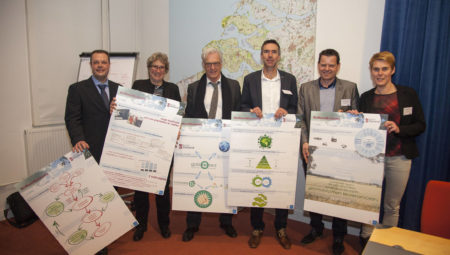Each year, government spends approximately 70 billion euros on procurement. You can achieve a lot of sustainability with this. There is no lack of good will and agreements. From ministries and provinces to municipalities and from the Directorate-General for Public Works and Water Management (Rijkswaterstaat) to water authorities, sustainability and circularity are high on the procurement agenda. More than 160 government organisations have signed the Socially Responsible Procurement (MVI) manifesto and have formulated action plans. Furthermore, Green Deals are eagerly pursued. ‘There is nothing wrong with the policy,’ confirms Robbert Naus of Dura Vermeer. ‘But there is a huge gap between policy and implementation. Once you reach the project stage, project managers, schedules and budgets take the upper hand.’ This is where things come to a halt.
Blanketed
The situation is even more pressing for biobased procurement. Biobased procurement is one of the MVI manifesto’s themes. But you will find very little mention of this in the various documents, such as the MVI action plans, and even less in actual practice. According to data supplied by government organisations themselves, the share of such procurement is staying stuck at 2-3 percent. For circular procurement this is three times as high (see sidebar).
Biobased procurement would appear to be becoming the victim of the popularity of socially responsible and circular procurement. ‘We are seeing a shift from biobased to the circular economy, CO2 reduction and energy,’ says Martin Scherpenisse of the Province of Zeeland, who since 2013 has pioneered biobased procurement. ‘Biobased procurement is being pushed into the background. This is not a good thing. Biobased procurement is essential for achieving circular objectives. It surprises me that this relationship is not clear to everyone.’ Diederik Heij of the PIANOo Dutch Public Procurement Expertise centre also sees this happening: ‘Circular procurement is absolutely blanketing biobased procurement. Biobased procurement is not an aim in itself. You have to be very careful about this. It must provide added value. Circular is the cake, biobased the cherry. However, ultimately there will need to be a large share of biobased materials if you want to replace fossil raw materials.’
Complex
It is rather difficult for procurement officers to do all this well. For the average procurement officer, socially responsible sounds more familiar than biobased. ‘Biobased procurement is complex,’ Heij explains. ‘Experts are quick to express themselves using chemical terminology. If you are not familiar with this, you quickly disengage.’ Scherpenisse also acknowledges this. ‘A procurement officer may very well tell an architect to use biobased materials, but the chances are great that the procurement officer will have no idea what is going to be installed.’
This complexity may explain why most projects are in the civil and hydraulic engineering and construction sector. Of the 35 initiatives mentioned on PIANOo’s MVI Biobased Map, 18 are in the civil and hydraulic engineering sector, 9 are in the public space and 2 are in the construction sector. ‘Strange, really,’ says Naus. ‘It is a conservative sector. It is difficult to get new things off the ground here.’ According to Heij, the reason for this elevated share is due to the many engineers working in this sector. ‘They are more easily inclined to make biobased purchases. Entities such as Rijkswaterstaat and the Central Government Real Estate Agency (Rijksvastgoed) often have their own knowledge departments. These play a key role in direction-setting.’ According to Heij and Scherpenisse, high volumes are furthermore involved here with which a relatively high gain in sustainability can be achieved. ‘We look at those areas where we can have the most impact,’ says Scherpenisse. ‘Furthermore, you want to develop in areas with visibility. Everyone likes to open a biobased road.’
Nevertheless, biobased procurement only represents a minor share in these sectors as well. Heij: ‘People are more apt to perceive opportunities for achieving sustainability gains in the technical cycle rather than in the bio cycle. Yet, this gain can also be achieved when you replace fossil materials with biobased materials.’ Naus also acknowledges this: ‘If we are given the opportunity, we incorporate it, but the number of customers prepared to experiment with this are few and far between.’
Are the supply and demand actually sufficiently in sync? Naus: ‘I believe so. Climate and circular objectives are at the forefront for customers. For example, for us bitumen for asphalt is becoming more scarce because refineries are increasingly producing other products from oil. This is why we need to look for alternatives. Even if it’s driven by different considerations, we’ll find each other in the end.’
‘There is nothing wrong with the policy, but there is a huge gap between policy and implementation’
Upscaling
We need to scale up, the involved parties emphasise. ‘We need to leave the domain of inspiring examples behind and move towards increased mass and professional specifications,’ says Heij. According to Scherpenisse, the supply has not been developed far enough. While every product group now offers something, the mass is lacking. ‘The first project is easy,’ Naus adds. ‘It creates a lot of publicity for both parties. The second and third projects are also fairly easy. But I don’t really see the fourth and subsequent projects happening. This is when you run into issues with price, availability and cold feet. If biobased materials were to be undisputed, and the quality just as high as and cheaper than fossil versions, we would succeed within a year. But this is not the way it is.’
Why is that? Have we not been talking about scaling up for years? What is really helping according to Heij are the 13 Sustainable Buyer Groups initiated at the start of 2020. In these groups, the Central Government, the Association of Provincial Authorities (IPO), the Association of Netherlands Municipalities (VNG) and the Employee Insurance Agency (UWV) are working on a joint market vision and strategy designed to make a product category sustainable. They want to send a clear signal to the market this way. ‘You must do this together with the market,’ says Heij. Naus endorses this. The road builder is involved in the Chaplin project to process lignin in asphalt. ‘A collective of customers. contractors and knowledge institutions is researching the technical and commercial aspects. Municipalities have been asked to make test sections available. In two years’ time we will be able to judge whether the quality is the same. If so, it will then be offered to all customers. This is the right method.’ Dura Vermeer has also constructed a one-kilometre biobased section for the N213 provincial road in the Province of North Holland. ‘It’s good to see that the province is simply going ahead and doing this,’ says Naus. ‘Research will have to demonstrate how this turns out over the coming years. They are not going to wait 10-20 years if there is any damage. Furthermore, when we have something new, we are obliged to provide it. It is a ten-year testing ground and therefore much more than a demonstration project.’
Testing is Indispensable
For a roundabout in the N62 provincial road (Tractaatweg) in the Province of Zeeland, it was the contractor who suggested biobased frames with directional arrows. Scherpenisse: ‘It is now up to us to test these frames to ensure they do not warp, blow away or are crushed by traffic. When these frames are produced in series of a thousand, they are even cheaper than regular frames. The lower transport and installation costs are a further benefit.’ This is why, for the purpose of upscaling, Scherpenisse has been arguing for years for a database with biobased products. ‘When you don’t know what’s available for sale, you can’t ask for it. Without a database, you are forced to approach every supplier.’
When you want to scale up, it is even more crucial for a product to be demonstrably biobased. ‘If you do not know what it is, you need specialists who can tell you whether the product is biobased,’ says Scherpenisse. ‘Because all suppliers are suddenly saying that their products are biobased. You have to be able to test this.’ Naus concurs: ‘When you manufacture wooden guiderails or traffic signs made of laminated bamboo, this is visible. But you cannot see the lignin mixed in with asphalt. When, as customer, you ask for a biobased binding agent, all kinds of suppliers all of a sudden claim that their product meets this criteria. How do you check this? You need a certification system that excludes “cowboy behaviour”. This does not worry me too much for a test section, but it is a concern when larger projects are involved.’
‘When you don’t know what’s available for sale, you can’t ask for it. Without a database, you are forced to approach every supplier’
Procurement Obligation
Has the time come for imposing certain procurement obligations? There is a difference between an obligation imposed by the Central Government and a minimum requirement imposed by government organisations. Currently, the Central Government has not set a certain mandatory percentage for biobased materials. While government organisations have signed a manifesto, they are not held to account for this. An obligation imposed from above works, but it is of course better when there is a decentralised desire and need to procure biobased materials together with the market.’ Scherpenisse is observing an increase in the pressure exerted by the national political establishment. ‘However, 50% circular by 2030 is not a provincial target. The Association of Provincial Authorities (IPO) is working on an administrative order directing all procurement officers to start working on a circular basis. In my view, biobased should form part of this. However, it will not be possible to make this mandatory in every province, because unfortunately it does not have the same priority everywhere.’
‘Biobased is not an aim in itself. You have to be very careful about this. Circular is the cake, biobased the cherry’
Would it help if the organisation itself made it mandatory? Heij: ‘A procurement officer can include a hard requirement for biobased materials. Such a requirement would be black and white. He can also include it as an award criterion whereby biobased is one of the sustainable alternatives. Government organisations are more inclined to include it as a requirement rather than an award criterion. When you include it as a requirement, you exclude other alternatives that may be more sustainable. Government organisations are struggling with this.’ This is not as much of a concern for Scherpenisse. ‘We really delve into this. For all tenders in excess of €50,000 we review the possibility of purchasing biobased. Prescribing a biobased alternative is a conscious choice. Even if this may be against the rules. We provide many grants and help start-ups. So it does not make any sense if you subsequently fail to ask for biobased.’ The Four-Year Action Plan of the Province of Zeeland included twelve biobased projects. After three years this has risen to fourteen. ‘Twelve is not a huge number,’ says Scherpenisse, ‘but the Board is really held accountable.’ According to Naus, an obligation works by definition. ‘But the question is whether it would make sense at the present time. We still have insufficient knowledge about biobased materials. A customer could certainly make it mandatory at some point in time. I am convinced of that. In the beginning you could give it a boost through means of the award criteria. This way you stimulate companies. Over time it can be specified as a requirement, after which it becomes the standard.’
Keep Asking
Things are taking very long. Can this not be sped up? Heij: ‘Procurement should be done very differently. Making the transition to the organisation and budgets takes time. The tendering process should be turned on its head. Procurement officers must look beyond the acquisition price and also include other benefits: payoffs earned further along during the service life and the social costs. Due to the EMAT criteria, the acquisition price has already become less dominant. Organising circularity is important. Solely focusing attention on biobased origin is unwise if you did not make arrangements in advance about how the material is going to be reused or recycled after its service life. This is not something that can be settled over a period of one to two years.’
As far as Scherpenisse is concerned, his province should further refine its targets. ‘As government you must keep asking for biobased products. Otherwise the initiates will fall apart again, such as the biobased scooter. While everyone thought it was a great idea, it never became more than a gadget. Unfortunately, the supplier has since gone bankrupt.’ Naus does not think it matters too much if things take longer. ‘Of course this is not what I am hoping for, but I can understand it. You need to give it a chance to grow. This does not need to happen all at once. I am certain that things will move in the right direction.’ Scherpenisse: ‘We will simply keep moving forward.’








